How much fun can you have with $25 worth of ETH?
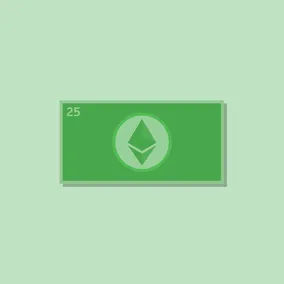
Leo Bauza, Former Front-End Development Technical Director
Article Category:
Posted on
Used to be that you could have fun watching $25 worth of ETH become $10,000 just by hodling it. These days we have to work harder.
“I think there must be a MetaMask seed somewhere that I forgot to properly back up, all the ether in it lost forever.” - Me, upon realizing I don’t own any ether.
Toshi and Status are two browsers I wrote about in Are These Browsers Going to the Moon?. To get the full experience of using them you need bit of ether (the Ethereum blockchain native token, also referred to as ETH.) Unfortunately, I had none. I had no choice but to head over to Coinbase and buy $25 worth of the stuff, for science. What follows is what I did with those $25 dollars while testing out Toshi and Status.
16 July, 2018 #
I bought $25 worth of ether at $481.37 per ETH minus Coinbase’s fee, a whopping $1.49. Right off the bat Coinbase took about 6% of my money, that was the first bit of fun I had with my $25 dollars. I was off to a good start. “Start” might be overstating it though, my transaction wouldn’t be cleared by my bank for a few days, until that happened I could not touch my ether. Aren’t centralized systems the worst? In just a few days I would be the proud owner of 0.04883927 ETH, a number as easy to wrap your head around as blockchain technology.
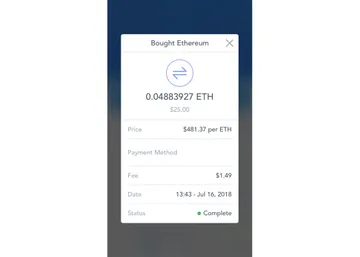
I had already downloaded Toshi and signed up for the beta testing of Status. I went through all the standard set up for cryptocurrency wallets: write down your seed phrase on a piece of paper, memorize it, then come up with an elaborate way to safely store it and protect it from fires, floods, kidnappings, and all sorts of natural and manmade disasters. Toshi and Status both do a good job of guiding users through the process of getting set up. Both Status and Toshi let me set a password to protect against someone using my phone to spend my ether and sign transactions. Conveniently, Toshi let me use touch ID. There wasn’t much I was going to be able to do with these without my ether, so I closed the apps and waited.
20 July, 2018 #
The trading price of ether was now at $469.31 per ETH. Not ideal, but not disastrous. Cryptocurrency prices tend to swing wildly. I have to admit I was hoping it would swing wildly in the other direction, but whatever, at least now I could get started spending my riches.
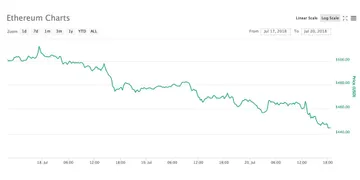
I sent each of Toshi’s and Status’ native wallets about half my ether. Finally the fun was about to begin, right after the two transactions got enough confirmations. A few minutes later I was ready to spend my $22.07 worth of ether. That’s right, almost $3 dollars went to onboarding costs including exchange fees, transaction fees, and market changes. To be fair I could have done this a lot faster by just asking a friend to sell me $25 worth of ether and paid a few pennies on transaction fees, but I love giving Coinbase my money and criticizing the crypto onboarding experience too much.
One episode of Grand Designs on Netflix Later #
Ready to enter the decentralized world promised to me last year at ETHWaterloo, I fire up Toshi on my iPhone 5s, a true stress test. Toshi looks pretty good, it has a nice big search bar, some curated dApps to choose from and a handy menu at the bottom to access dApps, chats, the wallet, and settings.
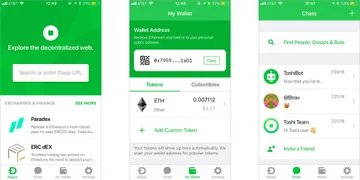
The first thing I did was open the chats. There was a welcome message from Toshibot who offered me some free money after I had confirmed I was a real person by giving them my phone number and entering a code. I suppose this is so they don’t get scammed and to harken back to everything I hate about other apps, like giving them my email and phone number so I can get spammed later. I used a burner phone and my standard spam email address to get Toshibot to fork over some ether, but alas Toshibot was out of money and told me to check back soon.
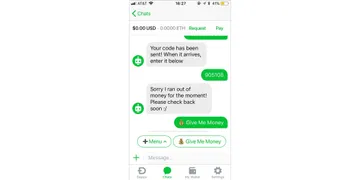
After my disappointing encounter with Toshibot, I asked a friend to download Toshi to help me test the chat. Chat is encrypted end-to-end using the Signal Protocol by Open Whisper Systems which is great. I was able to chat with my friend without the NSA snooping and sent him some ether through the app. The payment mechanics are about as easy to use as the Cash App or Venmo.

It was time now to switch over to Status and see what it had to offer. Using the chat is very similar. Disappointingly, there is no Statusbot to give me money. I sent the same friend more ether through the chat; at this pace he will be able to retire soon. The user experience here is much worse than in Toshi. It relies on you typing out commands like “/send” then entering a currency and then an amount. A help menu pops to assist you in this, but that doesn’t make it much better.
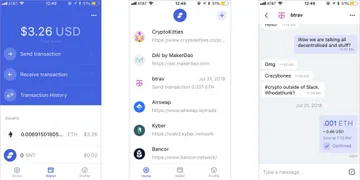
One great thing about Status is that it uses the completely decentralized Whisper protocol for messaging (no relation to Open Whisper Systems or the Signal Protocol). This relies on no central servers and all communication is encrypted and propagated in an entirely peer-to-peer way. Contrast that with Toshi which relies on central servers for communication. In Toshi’s defense they encrypt communications end-to-end.
At this point it was late and I didn’t want to waste my precious crypto on just anything. I looked around and considered what dApps I would try out the following day. One thing was for sure, I was going to finally buy a cryptokitty.
21 July, 2018 #
Toshibot has money again! Rejoice!
The “free money strategy” has been used by payment apps before, for example the Cash App gives you $5 and with the right code donates $5 dollars to a cause. They do that hoping to pull you away from the “other apps” as they onboard you. Toshi on the other hand gives you 0.0007 ETH ($0.33 USD) in hopes of breaking you up with central banks and the way you’ve comfortably lived your entire life, as they onboard you. Toshi also gives to charity, though. After you receive your free ether, Toshibot will ask if you’d like to donate to charity. I, of course, said I would. Toshibot then walked me through the process of sending a payment (the donation) using Toshi for 0.0000 ETH ($0.01 USD). That’s the amount Toshibot automatically requested from me to give to charity, not an amount I picked myself. The transaction fee was ~$0.11 USD.
We’re more than halfway through this blog post and the astute reader will notice we haven’t even opened a dApp yet. That’s all about to change.
The first dApp I decided to try was Peepeth, a decentralized twitter clone built using the ethereum blockchain and https://ipfs.io/. Peepeth is “invite only” but as soon as you request an invite you are invited. After being invited, I created an account which was “free” in the still-having-to-pay-a-network-transaction-fee meaning of free. While I thought of what my first “peep” should be, I browsed around to see what others were “peeping.” It was underwhelming to say the least. I guess it should cost more to save something to an immutable decentralized ledger. “The Indicator is an underrated podcast” was the thought I decided to immortalize forever on the blockchain. Peepeth congratulated me on my first peep, then asked me if I wanted to save it to the blockchain (I thought I already had? But I guess I hadn’t.) and then I went through two screens to pick a gas cost and confirm the payment. When all was said and done I spent less than a dollar on Peepeth, but what worries me is that I’ll never get that time back.
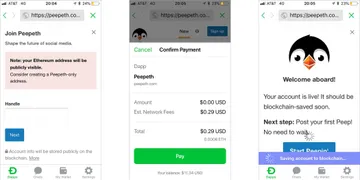
An episode of Billions on Showtime later #
I was really hoping to speculate on some ERC-20 tokens on a decentralized exchange (dex) but, after reading their terms of service, as an American I can’t. Still, I wanted to check out the experience of using a dex up until the fun part of throwing away my money on useless maybe-securities.
I opened up DDEX and poked around. My memories of dex’s consisted of watching folks at ETHWaterloo use EtherDelta (trust me you don’t want a link to it.) It was a terrible user and spectator experience. DDEX seems different. The interface looks a lot of more like Coinbase Pro (formerly GDAX). DDEX doesn’t require deposits like EtherDelta; it uses off-chain order relay with on-chain settlement utilizing the 0x protocol. That means, market makers don’t need to pay a transaction fee to add a trade to the order books, but takers do have to pay a fee to complete the trade. Liquidity is a big problem for decentralized exchanges – the volume of trades currently handled by dex’s is extremely low compared to their centralized counterparts. As it turns out DDEX is the first implementation on top of hydro, another protocol seeking to have inter-exchange liquidity.
Without actually doing any trading it’s easy to see all the pain points that still remain in using a dex. There is obviously no way to onboard with fiat money (eg. USD). Then, once I have some ether I need to go through the confusing process of converting my ether to wrapped ether (WETH). WETH is needed because ether itself is not ERC-20 compatible. In order to trade ether for any ERC-20 token using this system, it has to be wrapped in a ERC-20 compatible layer. I went ahead and wrapped some ether. I am not sure that, without my prior knowledge, I would have known what the heck was going on exactly. After this point I wasn’t able to do anything for two reasons. First, according to the terms of use I couldn’t, and second, there are minimum orders for more than the little ETH I had converted to WETH.
There are obvious advantages to a dex: there is no sign in, your trades are done directly with a counterparty, and you are closer to bringing down the centralized systems and culture of surveillance that are destroying everything that is good in the world.
The Time is Meow #
I’d be lying if I said I didn’t start all this mostly to buy cryptokitties. I am not a big fan of cryptokitties, but I am so surprised the idea worked at all. Cryptokitties are the first successful digital collectible, and that is interesting and puzzling.
Cryptokitties is one of the most usable dApps around. The mechanics of the game are straightforward and pretty easy to grasp, and its biggest problem is that prices are listed in ether, a pretty big mental hurdle for newcomers to the crypto space. After being presented with kitties in different price ranges, I bought the cheapest kitty I could find. Kitties can be bought, sold, or bred. As a pawrent you can breed your cat either by starting a sire auction and letting other users breed with your cat for a price, or by bidding on an existing siring auction and producing a new kitty for your collection. You may also choose to put your cat up for sale or to gift your cat to a friend.
Cattributes are determined by a DNA string stored on the blockchain, that DNA string is the piece of data you own. By day’s end I had 5 kitties with a myriad of cattributes, none of which were the rare cattributes that make some of these cats sell for thousands of dollars. Playing this game is fun for a while, but soon my cryptokitties became about as fun as having staring at a beanie baby collection, and probably about as valuable.
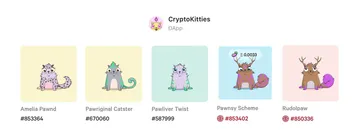
If you consider the cryptokitties white pa-purr as the bar by which you measure this dApp, it is a success. They pioneered the ERC-721 non-fungible token. Their game mechanics work, from the descending clock auctions to the releases of fancy and exclusive cats. For a while there, and maybe still, they also made a ton of money.

Cryptokitties isn’t without problems. It is debatable whether you “own” the cryptokitty you bought in the full sense of the word. Also, it gets boring alarmingly quickly, but they are trying to fix that with the Kittyverse. At the end of the day, I have five cats I won’t think about much. Luckily, they won’t starve or die like my old tamagotchis.
Roughly $25 from the moment set out on this endeavour to waste $25 #
I spent the weekend switching back and forth between Toshi and Status trying to decide which of these two apps worked better. They are pretty much the same except for the few differences in paying and requesting payments I mentioned earlier. Status annoyingly does not warn you that you are about to close a dApp when you press the “x” on the top left hand corner. I must have accidentally exited dApps a hundred times over the weekend. It’s ok, though. I left feedback for the Status team. By the time you read this I may have saved you that particular frustration, you are welcome.
It may seem like our decentralized future is totally unusable and kind of not worth it, and that may be the case. However, I like to imagine what I’d be writing about if I were spending a weekend trying this internet thing in 1996 (my first memory of the internet). I would probably start that web log post with me, sitting in front of my Compaq Pressario, listening to the sweet sounds of my dial up modem, and thinking the internet couldn’t be any more underwhelming.